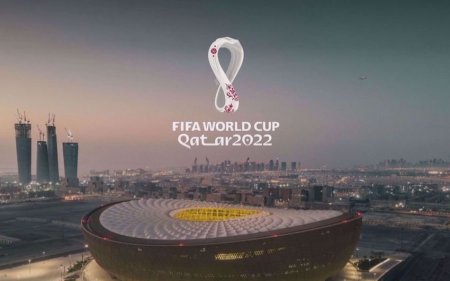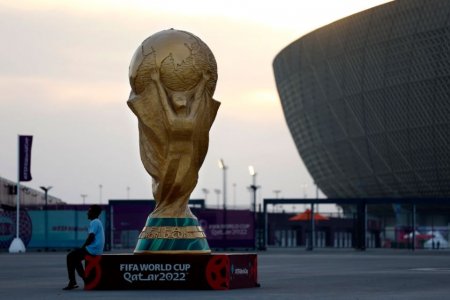The cost of the 2022 World Cup in Qatar: how much money did the owners of the most expensive men's FIFA tournament in history pay
Опубликовано: 19-11-2022, 09:20, , 711, 0
The 2022 FIFA World Cup in Qatar will be the most expensive tournament in the history of the tournament after the host nation prepared for the event by spending more than 16 times what previous host Russia had invested.
Back in December 2010, former FIFA President Sepp Blatter announced that Qatar would host the 2022 World Cup, sparking a wild celebration in the streets of Doha.
Over the next 12 years, Qatar launched the largest infrastructure project in the history of the World Cup to ensure that stadiums, transport links, airports and accommodation facilities are ready for the big match.
As close to a million visitors arrive in Qatar to watch the 2022 FIFA World Cup, there is a lot of debate about the cost of the tournament's infrastructure and a lot of controversy around it.

The country's finance ministers have admitted to spending $500 million a week for years on an infrastructure project, but the highest amount confirmed by a Qatari official was $200 billion, according to the Russian TASS news agency.
Attempts to piece together an accurate estimate of the overall cost of the World Cup have been hampered by various cost claims for infrastructure elements such as stadiums, hotels and transportation over the past 12 years.
The TASS report cites a $6.5 billion figure for the cost of eight World Cup stadiums, according to Fatma Al Nuaimi, executive director of communications for the Supreme Committee for World Cup Implementation and Legacy.
Previously, committee general secretary Hassan Al Thawady suggested the stadium was worth $8–10 billion when asked at the Chatham House Policy Institute in London in 2016.
The cooling systems in all but one of the eight stadiums used in the World Cup are said to have dramatically increased construction costs as designers introduced technologies that would keep players, fans and World Cup fields at a suitable temperature.
The turf to be used on the World Cup fields was grown in special nurseries using imported grass seeds and needs to be kept cool and well watered to keep it in good condition for football in the arid Qatari climate.
In addition to the money spent building or renovating the eight World Cup stadiums, huge sums have also been spent on housing, including private islands, villas, apartments and hotels.
In Doha alone, more than $15 billion has been spent on a residential development known as The Pearl, while $36 billion has been spent on the Doha Metro.
Elsewhere, an entire city was built around Lusail Stadium. Lusail City will have 22 hotels and enough housing for 200,000 residents, as well as a theme park, two marinas and two golf courses.
Here are the announced prices, according to UK Sky News, for venues that will host 64 World Cup matches in November and December:
Stadiums and other infrastructure projects for the 2014 FIFA World Cup in Brazil cost $15 billion, while the 2018 World Cup in Russia cost $11.6 billion.
None of these numbers come close to the estimated cost of the 2022 World Cup in Qatar, which is without a doubt the most expensive World Cup in history.
The tournament also caused human and financial losses.
Many of these workers were reportedly required to pay up to US$4,000 to receive contracts in Qatar, promising well-paid jobs and good conditions.
During the 12-year FIFA World Cup infrastructure project, workers returned home from Qatar reporting low wages of less than $1 an hour for 12-hour shifts, including during the summer months when temperatures in Qatar reach 43 degrees Celsius.
Global criticism has prompted Qatar to make changes to its labor policy ahead of the tournament, including a minimum wage of 1,000 rials ($275) a month.
While these changes are welcome, many will wait until the end of the tournament to assess the final cost - financial and otherwise - of the 2022 FIFA World Cup in Qatar.
Back in December 2010, former FIFA President Sepp Blatter announced that Qatar would host the 2022 World Cup, sparking a wild celebration in the streets of Doha.
Over the next 12 years, Qatar launched the largest infrastructure project in the history of the World Cup to ensure that stadiums, transport links, airports and accommodation facilities are ready for the big match.
As close to a million visitors arrive in Qatar to watch the 2022 FIFA World Cup, there is a lot of debate about the cost of the tournament's infrastructure and a lot of controversy around it.

How much did Qatar pay to host the World Cup?
Qatar has reportedly spent $229 billion on World Cup infrastructure, though the official World Cup team has not confirmed this figure.The country's finance ministers have admitted to spending $500 million a week for years on an infrastructure project, but the highest amount confirmed by a Qatari official was $200 billion, according to the Russian TASS news agency.
Attempts to piece together an accurate estimate of the overall cost of the World Cup have been hampered by various cost claims for infrastructure elements such as stadiums, hotels and transportation over the past 12 years.
The TASS report cites a $6.5 billion figure for the cost of eight World Cup stadiums, according to Fatma Al Nuaimi, executive director of communications for the Supreme Committee for World Cup Implementation and Legacy.
Previously, committee general secretary Hassan Al Thawady suggested the stadium was worth $8–10 billion when asked at the Chatham House Policy Institute in London in 2016.
What did Qatar spend money on?
The total expenses paid by Qatar are staggering, but pinpointing exactly what the money was spent on is not an exact science.The cooling systems in all but one of the eight stadiums used in the World Cup are said to have dramatically increased construction costs as designers introduced technologies that would keep players, fans and World Cup fields at a suitable temperature.
The turf to be used on the World Cup fields was grown in special nurseries using imported grass seeds and needs to be kept cool and well watered to keep it in good condition for football in the arid Qatari climate.
In addition to the money spent building or renovating the eight World Cup stadiums, huge sums have also been spent on housing, including private islands, villas, apartments and hotels.
In Doha alone, more than $15 billion has been spent on a residential development known as The Pearl, while $36 billion has been spent on the Doha Metro.
Elsewhere, an entire city was built around Lusail Stadium. Lusail City will have 22 hotels and enough housing for 200,000 residents, as well as a theme park, two marinas and two golf courses.
Cost of 2022 World Cup stadiums
The construction of eight stadiums capable of hosting World Cup matches brought a lot of attention to the preparation of Qatar's infrastructure.Here are the announced prices, according to UK Sky News, for venues that will host 64 World Cup matches in November and December:
| Stadium | Location | Estimated cost |
| Al Beit | Al Khor | $847 million |
| Lusail | Lusail City | $767 million |
| educational city | Al Rayyan | $700 million |
| Al Janub | Al Wakra | $587 million |
| Ahmad bin Ali | Al Rayyan | $360 million |
| Al-Tumama | Doha | $342.5 million |
| Khalifa International | Doha | $280 million* |
| Stadium 974 | Doha | Cost unknown |
Is this the most expensive World Cup in history?
According to 1win , South Africa spent $3.6 billion for the 2010 World Cup, spending less on infrastructure than previous host nations Germany ($4.3 billion in 2006) and Japan and South Korea ($7 billion in 2002).Stadiums and other infrastructure projects for the 2014 FIFA World Cup in Brazil cost $15 billion, while the 2018 World Cup in Russia cost $11.6 billion.
None of these numbers come close to the estimated cost of the 2022 World Cup in Qatar, which is without a doubt the most expensive World Cup in history.
The tournament also caused human and financial losses.
Why the 2022 World Cup in Qatar is controversial
A massive migrant workforce was hired to build the infrastructure for the World Cup, with hundreds of thousands of workers coming from countries like India, Nepal and Bangladesh.Many of these workers were reportedly required to pay up to US$4,000 to receive contracts in Qatar, promising well-paid jobs and good conditions.
During the 12-year FIFA World Cup infrastructure project, workers returned home from Qatar reporting low wages of less than $1 an hour for 12-hour shifts, including during the summer months when temperatures in Qatar reach 43 degrees Celsius.
Global criticism has prompted Qatar to make changes to its labor policy ahead of the tournament, including a minimum wage of 1,000 rials ($275) a month.
While these changes are welcome, many will wait until the end of the tournament to assess the final cost - financial and otherwise - of the 2022 FIFA World Cup in Qatar.




